
Cover image: Blaine Moats Cover design: Suzanne Sunwoo Copyright 2013 by Meredith Corporation, Des Moines, IA. All rights reserved Published by Houghton Mifflin Harcourt Publishing Company, New York, New York Published simultaneously in Canada For information about permission to reproduce selections from this book, write to Permissions, Houghton Mifflin Harcourt Publishing Company, 215 Park Avenue South, New York, New York 10003. www.hmhbooks.com Library of Congress Cataloging-in-Publication Data Better homes and gardens the ultimate soups and stews book: more than 400 satisfying meals in a bowl. p. cm.
Includes index.
ISBN 978-1-118-33561-1 (pbk.); 978-0-544-18851-8 (ebk.)
1. 2. Stews. 3. 3.
One-dish meals. I. Better homes and gardens. II. Title: Ultimate soups and stews book.
TX757.B433 2013
641.813dc23
2012011968 Meredith Corporation Editor: Jan Miller Contributing Editor: Lois White Recipe Development and Testing: Better Homes and Gardens Test Kitchen Houghton Mifflin Harcourt Publisher: Natalie Chapman Editorial Director: Cindy Kitchel Executive Editor: Anne Ficklen Executive Editor: Linda Ingroia Editorial Associate: Heather Dabah Production Editor: Jacqueline Beach Interior Design: Jill Budden Layout: Holly Wittenberg Production Director: Tom Hyland Our seal assures you that every recipe in The Ultimate Soups & Stews Book has been tested in the Better Homes and Gardens Test Kitchen. This means that each recipe is practical and reliable and meets our high standards of taste appeal.
We guarantee your satisfaction with this book for as long as you own it.  v1.0313 Introduction
v1.0313 Introduction 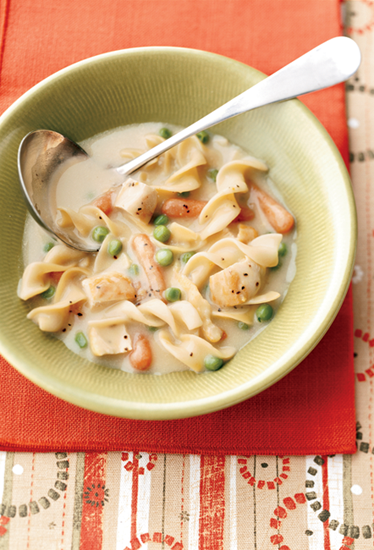 soups for every season! No matter the time of year, nothing can be more satisfying than a bowl of soup. Much of the appeal of this comfort food comes from its glorious aromas and so many distinctive flavors and styles, whether creamy or clear, casual or elegant, brimming with seafood or thick with vegetables. But more than ever, soups and stews are a way to bring fresh, seasonal flavors to the table. Dish up any one of the extraordinary recipes in this collection and youll be sure to draw rave reviews every time. From the timeless classics to soups with innovative ingredient pairings, the recipes cover every coursefrom appetizers to desserts.
soups for every season! No matter the time of year, nothing can be more satisfying than a bowl of soup. Much of the appeal of this comfort food comes from its glorious aromas and so many distinctive flavors and styles, whether creamy or clear, casual or elegant, brimming with seafood or thick with vegetables. But more than ever, soups and stews are a way to bring fresh, seasonal flavors to the table. Dish up any one of the extraordinary recipes in this collection and youll be sure to draw rave reviews every time. From the timeless classics to soups with innovative ingredient pairings, the recipes cover every coursefrom appetizers to desserts.
Whats more, you can easily adapt many of the recipes to incorporate ingredients you have on hand or leftovers you want to use. Look for icons that identify our best slow-cooker recipes as well as low-fat soups. Another bonus: Youll find basics on making homemade stock, customizing your own soups, and tips that show you how to master soups of all kinds. Making soup has never been so easy! Look for these tabs throughout to guide your recipe choices

soup-making
basics If you know how to boil water and have a few essential ingredients on handvegetables, meat, beans, and/or grainsyou can make soup. To help you get started, here are a few basics on making rich soup stocks, plus techniques for cooking and freezing soups and stews. soup terms Not all soups are alike. soup terms Not all soups are alike.
Texture, consistency, and ingredients are what differentiate one soup from another. Here are several types of soups youll run across in this book. Bisque: a rich, thick, smooth soup thats often made with shellfish, such as lobster or shrimp. It is usually thickened by pureeing ingredients or adding cream. Chowder: a thick, chunky soup. Traditionally, a chowder is made with seafood or fish, but chowders made with poultry, vegetables, and cheeses have become popular.
Stock: a strained, thin, clear liquid in which meat, poultry, or fish has been simmered with vegetables and herbs. While normally used as an ingredient in other soups, it can be enjoyed as a light course on its own. Gazpacho: a vegetable soup served cold, often made with tomatoes as the key ingredient. Gumbo: hearty bowls of seafood, vegetables, and/or meat chunks that have thick broths and Creole seasonings. Stew: a very thick soup based on chunks of meat or occasionally fish and vegetables. * Stock your pantry with canned broth, stewed tomatoes, dried pasta, and herbs and seasonings. * Stock your pantry with canned broth, stewed tomatoes, dried pasta, and herbs and seasonings.
Combine with fresh veggies or leftover meat for a quick soup supper that offers home-cooked comfort. HOT or COLD To keep soup piping hot, serve it in warm bowls. Cold soups are more refreshing and stay cold longer when served in chilled bowls. Follow these guidelines to enjoy your soup at the right temperature. To warm bowls: Preheat your oven to the lowest setting; then turn it off. Place bowls in the oven for 5 to 10 minutes before serving time.
To chill bowls: Place bowls in the refrigerator for 10 to 15 minutes before serving time. Reheating soups: When reheating soup on the stove top, use high heat for broth-based soups and low heat for purees or cream soups. Bring soup to a gentle simmer until heated through. Stir as often as necessary to keep it from burning. Watch bean, potato, or flour-thickened soups closely, as they can burn easily. stock up Rich, velvety homemade stocks are the building blocks for many soups and stews.
Simmer chicken or meat, vegetables, seasonings, and water for a few hours to make your own pot of liquid gold. Stock your pantry When a recipe calls for broth, use one of the following convenient options to impart rich, distinctive flavor to your soups: * Canned broth: Use chicken, beef, or vegetable broth straight from the can or resealable carton. If you prefer lower-sodium varieties, use reduced-sodium or even unsalted chicken or beef broth. * Bouillon: Instant bouillon granules or cubes are available in chicken, beef, and vegetable flavors. Mix 1 teaspoon or 1 small cube with 1 cup water. * Condensed broth: Cans of condensed chicken or beef broth, which are stronger than regular-strength broth, are also a quick-fix option. * Condensed broth: Cans of condensed chicken or beef broth, which are stronger than regular-strength broth, are also a quick-fix option.
Dilute them for use according to the label directions.  chicken stock prep: 25 minutes cook: 212 hours makes: 6 servings 3 pounds bony chicken pieces (wings, backs, and/or necks) 3 stalks celery with leaves, cut up 2 medium carrots, unpeeled and cut up 1 large onion, unpeeled and cut up 4 sprigs fresh parsley 2 bay leaves 2 cloves garlic, unpeeled and halved 1 teaspoon salt 1 teaspoon dried thyme, sage, or basil, crushed 12 teaspoon whole black peppercorns or 14 teaspoon ground black pepper 6 cups cold water If using wings, cut each wing at joints into three pieces. Place chicken pieces in a 6-quart Dutch oven. Add celery, carrots, onion, parsley, bay leaves, garlic, salt, thyme, and peppercorns. Add the water. Bring to boiling; reduce heat.
chicken stock prep: 25 minutes cook: 212 hours makes: 6 servings 3 pounds bony chicken pieces (wings, backs, and/or necks) 3 stalks celery with leaves, cut up 2 medium carrots, unpeeled and cut up 1 large onion, unpeeled and cut up 4 sprigs fresh parsley 2 bay leaves 2 cloves garlic, unpeeled and halved 1 teaspoon salt 1 teaspoon dried thyme, sage, or basil, crushed 12 teaspoon whole black peppercorns or 14 teaspoon ground black pepper 6 cups cold water If using wings, cut each wing at joints into three pieces. Place chicken pieces in a 6-quart Dutch oven. Add celery, carrots, onion, parsley, bay leaves, garlic, salt, thyme, and peppercorns. Add the water. Bring to boiling; reduce heat.
Simmer, covered, for 212 hours. Remove chicken pieces from Dutch oven. Strain stock into a large bowl through two layers of 100-percent-cotton cheesecloth placed in a colander. Discard vegetables and seasonings. If desired, clarify stock.* If using the stock while hot, skim off fat. Or chill for 6 hours; lift off fat with a spoon.

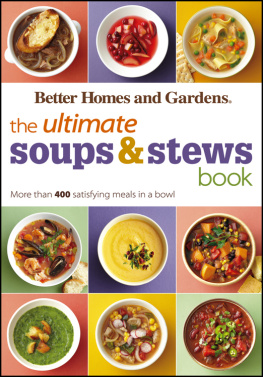




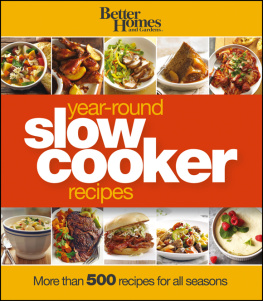

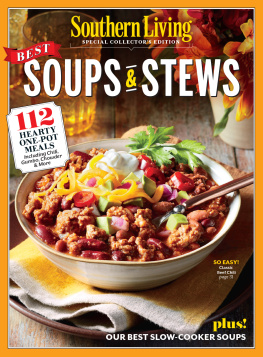

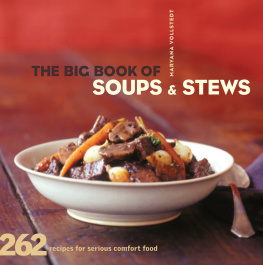
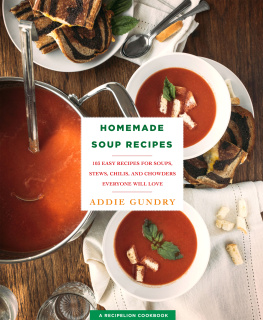

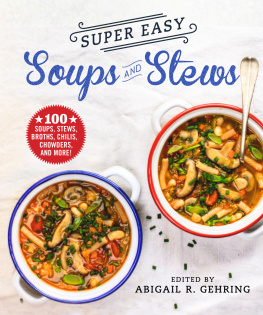
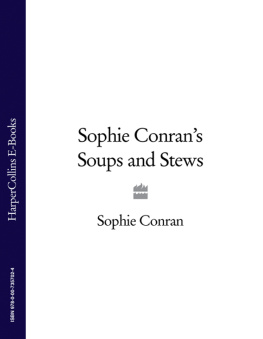
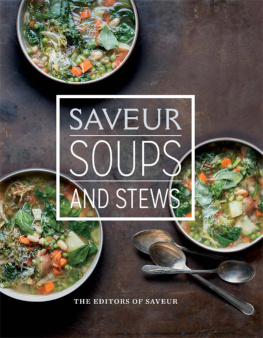
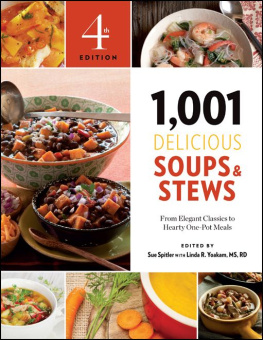
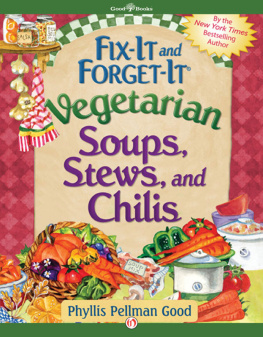

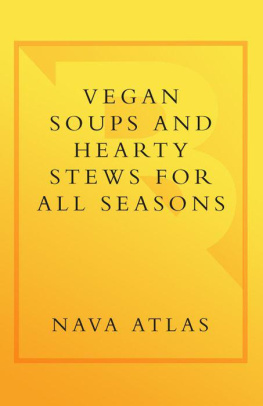

 Cover image: Blaine Moats Cover design: Suzanne Sunwoo Copyright 2013 by Meredith Corporation, Des Moines, IA. All rights reserved Published by Houghton Mifflin Harcourt Publishing Company, New York, New York Published simultaneously in Canada For information about permission to reproduce selections from this book, write to Permissions, Houghton Mifflin Harcourt Publishing Company, 215 Park Avenue South, New York, New York 10003. www.hmhbooks.com Library of Congress Cataloging-in-Publication Data Better homes and gardens the ultimate soups and stews book: more than 400 satisfying meals in a bowl. p. cm.
Cover image: Blaine Moats Cover design: Suzanne Sunwoo Copyright 2013 by Meredith Corporation, Des Moines, IA. All rights reserved Published by Houghton Mifflin Harcourt Publishing Company, New York, New York Published simultaneously in Canada For information about permission to reproduce selections from this book, write to Permissions, Houghton Mifflin Harcourt Publishing Company, 215 Park Avenue South, New York, New York 10003. www.hmhbooks.com Library of Congress Cataloging-in-Publication Data Better homes and gardens the ultimate soups and stews book: more than 400 satisfying meals in a bowl. p. cm. v1.0313 Introduction
v1.0313 Introduction  soups for every season! No matter the time of year, nothing can be more satisfying than a bowl of soup. Much of the appeal of this comfort food comes from its glorious aromas and so many distinctive flavors and styles, whether creamy or clear, casual or elegant, brimming with seafood or thick with vegetables. But more than ever, soups and stews are a way to bring fresh, seasonal flavors to the table. Dish up any one of the extraordinary recipes in this collection and youll be sure to draw rave reviews every time. From the timeless classics to soups with innovative ingredient pairings, the recipes cover every coursefrom appetizers to desserts.
soups for every season! No matter the time of year, nothing can be more satisfying than a bowl of soup. Much of the appeal of this comfort food comes from its glorious aromas and so many distinctive flavors and styles, whether creamy or clear, casual or elegant, brimming with seafood or thick with vegetables. But more than ever, soups and stews are a way to bring fresh, seasonal flavors to the table. Dish up any one of the extraordinary recipes in this collection and youll be sure to draw rave reviews every time. From the timeless classics to soups with innovative ingredient pairings, the recipes cover every coursefrom appetizers to desserts. soup-making
soup-making chicken stock prep: 25 minutes cook: 212 hours makes: 6 servings 3 pounds bony chicken pieces (wings, backs, and/or necks) 3 stalks celery with leaves, cut up 2 medium carrots, unpeeled and cut up 1 large onion, unpeeled and cut up 4 sprigs fresh parsley 2 bay leaves 2 cloves garlic, unpeeled and halved 1 teaspoon salt 1 teaspoon dried thyme, sage, or basil, crushed 12 teaspoon whole black peppercorns or 14 teaspoon ground black pepper 6 cups cold water If using wings, cut each wing at joints into three pieces. Place chicken pieces in a 6-quart Dutch oven. Add celery, carrots, onion, parsley, bay leaves, garlic, salt, thyme, and peppercorns. Add the water. Bring to boiling; reduce heat.
chicken stock prep: 25 minutes cook: 212 hours makes: 6 servings 3 pounds bony chicken pieces (wings, backs, and/or necks) 3 stalks celery with leaves, cut up 2 medium carrots, unpeeled and cut up 1 large onion, unpeeled and cut up 4 sprigs fresh parsley 2 bay leaves 2 cloves garlic, unpeeled and halved 1 teaspoon salt 1 teaspoon dried thyme, sage, or basil, crushed 12 teaspoon whole black peppercorns or 14 teaspoon ground black pepper 6 cups cold water If using wings, cut each wing at joints into three pieces. Place chicken pieces in a 6-quart Dutch oven. Add celery, carrots, onion, parsley, bay leaves, garlic, salt, thyme, and peppercorns. Add the water. Bring to boiling; reduce heat.